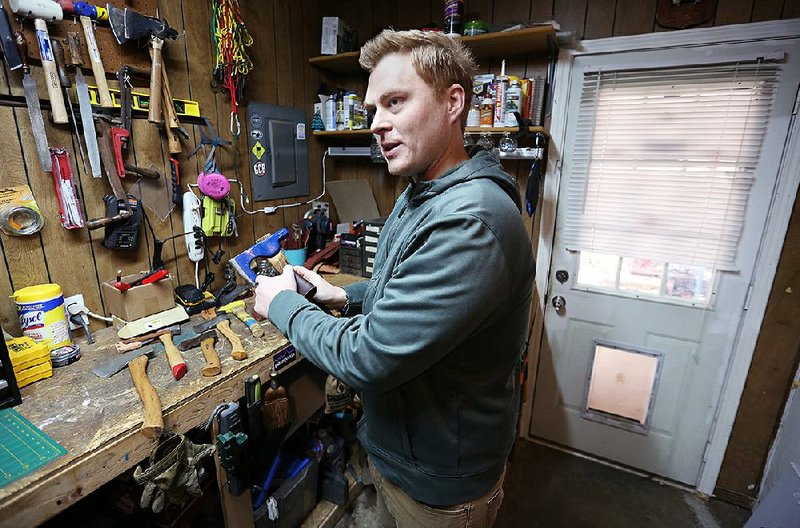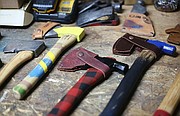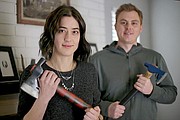Designer axes are sold out at Nordstrom.
But that doesn't mean Arkansans can't get a locally made ax with a similar splash of color.
Colby Bolinger of Fayetteville buys vintage American-made ax heads at auction, restores them and attaches them to handles made by Richland Handle Co. of Wesley.
Then an artist, Amber Bradshaw, paints the handles, sometimes with a sunrise or buffalo plaid.
The result is as eye-catching as it is utilitarian.
Bolinger, who works for a supply chain logistics company, said he got the idea to do painted handles after seeing pictures of axes from Best Made Co. a few years ago. It wasn't until about a month ago that Bradshaw, who works in retail, started painting handles for Bolinger's axes.
Bradshaw said painting designs on ax handles presents a challenge because they're curved.
Bolinger said designer axes are part of a bigger trend, along with the popularity of glamping -- a portmanteau of "glamorous" and "camping" -- and the back-to-nature movement.
People may be roughing it, but only to a degree.
"Overall, people are looking for quality over quantity in all aspects of life," Bolinger said.
They want their gear to be "picture worthy, as well," he said.
"I know people are willing to pay astronomical amounts of money for name-brand items that they can share on social media," Bolinger said. "Whether it's a Louis Vuitton bag or Gucci belt, axes have become a new accessory. I don't want to say it's the whole reason for the trend, but it is a part."
Ax prices at Bolinger's Knife & Tool range from $50 to $150. Those prices include leather sheaths made by Bolinger. Photos are available at instagram.com/ccbolinger.
There are other ax makers in Arkansas, like Ted Frizzell and Kyle Kidder of Mineral Mountain Hatchet Works in West Fork. But they're not painting handles with stripes or plaids.
"We've been making custom cutlery for about 35 years now," said Barry Frizzell, who runs the business side of Mineral Mountain. "Custom knife work is custom knife work. Painting handles is a whole nuther world. We're talking decoration now."
Bolinger said he prefers to restore American-made axes from the 1940s to the 1980s. After that time period, most of the axes sold in the U.S. were being made overseas, he said, and the quality wasn't as good.
That doesn't mean all foreign axes are inferior.
Bolinger said three of the best brands are made in Sweden -- Hults Bruk, Wetterlings and Gransfors Bruk.
"Those in my opinion are Cadillac or Ferrari type axes," he said. "Those are worth the money."
How much money? About $350 for a top-end ax from Hults Bruk or Gransfors Bruk. Wetterlings didn't list prices on its website.
The Swedes have been making axes for a long time -- since 1697 in the case of Hults Bruk.
Meanwhile, back in the U.S.A., a graphic designer began making designer axes in 2009.
Peter Buchanan-Smith painted stripes on the handles of axes he sold through his boutique brand Best Made Co. In 2017, Best Made was acquired by Bolt Threads, a Bay Area biomaterials company. Buchanan-Smith left the company this year to pursue other endeavors, according to an article in The New York Times.
The only ax sold by the upscale retailer Nordstrom was Best Made's American felling ax: nordstrom.com/s/best-made-co-the-painted-american-felling-axe/5136506/lite.
A version of the same ax with a different paint job is still available at bestmadeco.com/products/american-felling-axe. The price? $368.
The designer ax trend is an attempt to reconnect with a lost masculinity in a hyper-civilized world, said Brooks Blevins, a professor at Missouri State University in Springfield who is an expert on Ozark Mountain culture.
It's part of what he calls the "primitive impulse" -- a "desire to avoid falling prey to the intoxicating comforts of modernity and to reconnect with something more authentic (even primal) in the human experience."
The trend can be seen in other archaic appliances besides axes -- things like designer cast-iron cookware and butter churns.
"The back-to-the-land movements that occur about every two generations in U.S. history are good examples of the primitivist spirit," Blevins wrote in an email. "I think we're in the most recent iteration of that tradition right now -- thus the ancillary primitivist spirit popping up in the beard revival, craft brewing and distilling, the foraged food movement, etc."
Blevins said the ax was essential to settlement of this heavily forested continent.
"There may have been no tool more important to the settlement of the Ozarks -- or of any other woodland place in North America in the 19th century," he said. "They were used not only for cutting down trees but for hewing the logs for log houses, barns, and other structures. Of course, the hewing was generally done with a broad ax, whereas the cutting down of trees and cutting up of firewood was done with a single- or double-bit ax (if no crosscut saw was available, which was usually the case until the late 1800s). Railroad tie hackers later made use of the broad ax to hew out ties."
Blevins said he's been carrying a sling blade behind the seat of his pickup ever since he broke his ax handle.
"The Billy Bob Thornton/Arkansas connection is just an added bonus," he said.
The Shiloh Museum of Ozark History has axes on display, but they are of the vintage variety.
"We have three broad axes on display in the museum: in the pioneer section, the timber exhibit, and in a covered wagon display," said Carolyn Reno, collections manager at the museum. "They were an essential tool of the settlement era and timber industry years."
Ax-throwing bars have opened in hipster enclaves across America, but $300 designer axes may be too fancy to fling at a wooden target.
Some people use designer axes as home design pieces, according to the Times article.
"I think this kind of stuff is just part and parcel of a resurgence in localism across the nation, not just here in the hills," said Jared M. Phillips, the author of Hipbillies: Deep Revolution in the Arkansas Ozarks, a book about a back-to-the-land movement in the 1960s and '70s.
"On the whole, I think that's a good thing, even if folks are paying way too much for custom axes when they could go down to their local hardware store and get an ax that will suit their needs -- and save money to boot."
At walmart.com, a Coleman camp ax can be had for $10.
SundayMonday on 12/22/2019


